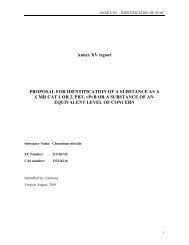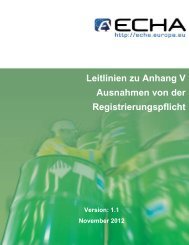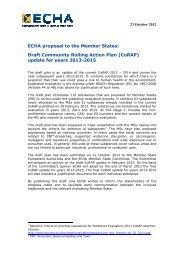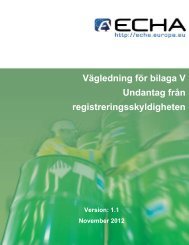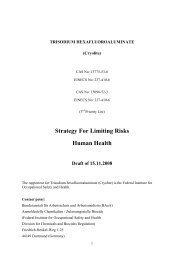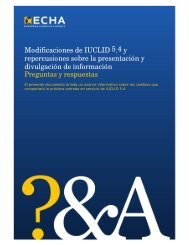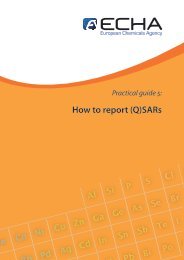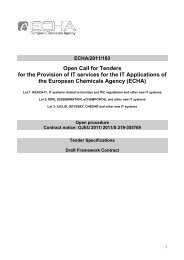EUBEES - ECHA - Europa
EUBEES - ECHA - Europa
EUBEES - ECHA - Europa
You also want an ePaper? Increase the reach of your titles
YUMPU automatically turns print PDFs into web optimized ePapers that Google loves.
sludge and river water. The decay trough the 3 environmental compartments sewer, activated<br />
sludge and river, was simulated using the following initial parameters (Table 3):<br />
Table 3: Assumed initial environmental parameters<br />
SEWER<br />
ACTIVATED RIVER<br />
SLUDGE (AS)<br />
Ammonium conc. (mg.l -1 ) 36 1 0.1<br />
FAC mg.l -1<br />
7.5 (max. value as calculated (model) calculated (model)<br />
estimated from<br />
HOCl consumption<br />
data)<br />
Chloramine (mg.l -1 ) 0 calculated (model) calculated (model)<br />
Reduced compounds (mg.l -1 S 2- ) 0.00015 0 0<br />
Organic material (mg.l -1 ) 300 3000 50<br />
Dilution factor in the river 10<br />
Residence time 1 h (3600 sec) 8 h (28800 sec) 10 min (600 sec)<br />
Simulations show a quick elimination of NaOCl/ClO - (expressed as FAC) (Fig. 2 a) during<br />
transport in the sewer. The abundancy of reduced reaction partners allows a fast initial FAC<br />
elimination reaction. The FAC concentration estimated at the end of the sewer drops below<br />
1.10 -32 µg.l -1 . The drop in FAC is in parallel with a sharp increase of the chloramine<br />
concentration, which can be explained by the high availability of ammonia in the sewer and<br />
the rapid reaction of NaOCl with NH 3 (within minutes). Chloramine further reacts as an<br />
oxidant during further transport in the sewer (Fig. 2 a), the activated sludge unit (Fig. 2. b)<br />
and in the river (Fig. 2 c). The extensive degradation of chloramine in the activated sludge<br />
unit can be explained by the presence of organic material acting as reductant. Chloramine is<br />
estimated to fall below 5.10 -10 µg.l -1 in the river.<br />
FAC decay and chloramine formation in<br />
8<br />
7<br />
6<br />
a<br />
FAC (t =20 s)<br />
1/2<br />
chloramine (t<br />
1/2<br />
= 1.5 h)<br />
FAC decay and chloramine formation in<br />
8<br />
7<br />
6<br />
a<br />
FAC (t =20 s)<br />
1/2<br />
chloramine (t<br />
1/2<br />
= 1.5 h)<br />
FAC decay and chloramine<br />
8<br />
7<br />
6<br />
b<br />
FAC<br />
chloramine (t 1/2 =11 min)<br />
5<br />
5<br />
5<br />
arrival in AS<br />
4<br />
4<br />
4<br />
(m<br />
g /<br />
l)<br />
3<br />
2<br />
(m<br />
g /<br />
l)<br />
3<br />
2<br />
(m<br />
g /<br />
l)<br />
3<br />
2<br />
1<br />
1<br />
1<br />
0<br />
0<br />
0<br />
0 500<br />
1000 1500 2000 2500 3000 3500<br />
0 500<br />
1000 1500 2000 2500 3000 3500<br />
4200<br />
4900 5600 6300 7000 7700 8400 9100 9800<br />
Time (seconds)<br />
Time (seconds)<br />
Time (seconds)<br />
Figure 2: Simulation of the decay of FAC and formation/decay of chloramine during<br />
transport in the environment.<br />
It has to be clear that due to the assumptions made during the setup of the model (i.e. 1: No<br />
decay of HOCl during the use phase; 2) No volatilisation of FAC/CAC and 3) No decay of<br />
26







